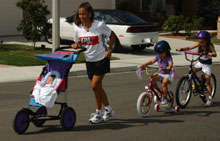 The Consumer Federation Of America offers the following advice for safe, efficient bicycle use:
The Consumer Federation Of America offers the following advice for safe, efficient bicycle use:
-
Helmets. Purchasing a bike helmet and getting your child to wear it on each ride is one of the most important things you can do for your growing child. Like childproofing your home or making sure she is buckled into a car safety seat, making bike helmet use a habit is a critical safety measure. Bicycle helmets are not just for bike riding either. You will want your child to wear a bike helmet when using a scooter, inline skates roller skates, skateboards or any activity in which he might injure his head from a fall.
-
Your child should always wear a bicycle helmet that is properly fitted and complies with Consumer Product Safety Commission standards. A helmet is required by law in many states
-
Supervision. Children under age six should always ride under the direct supervision of an adult, even on sidewalks. Teach your child about traffic hazards and pedestrians. Explain that even on sidewalks there are intersections with driveways and drivers may not be watching out for him and that he must be careful to avoid people and other children on the sidewalk.
-
Maintenance.
-
Periodically check your child's bicycle to make sure there are no loose nuts, bolts or screws. Check the owner's manual for the manufacturer's maintenance recommendations.
-
Check the brakes. If they make noise or do not stop the bicycle swiftly have them fixed by a bicycle mechanic.
-
Check the handlebars. Make sure the front wheel is straight and the handlebars are securely fastened. Also inspect the frame, fork, spindles and other components for cracking.
-
Examine the chain; there should be no caked grease or dirt and it should not be dry or rusty.
-
Check the tires by pushing them against a curb; if you can flatten them, more air is needed. Inflate to the pressure shown on the side of the tire. Do not over-inflate. Replace worn tires.
-
Make sure the seat does not rock or turn in any direction and the handlebars are not loose. The seat should be high enough so that your child's leg is slightly bent at the knee when the pedal is at the lowest point of rotation. Be sure your child's feet can reach the ground easily in case he has to get off in a hurry.
-
Check for broken spokes and make sure the wheel's axle nut is tight. Be sure the wheels spin freely and that the rims do not rub against the frame or fenders as they rotate.
-
-
Storage. Keep bicycles indoors when not in use. Moisture may cause rust and weaken metal parts.
-
Shoelaces. Teach your child to make sure his shoelaces are tied and long pants are secured around the ankle before getting on the bicycle so that they can't get caught in the chain.
-
Nighttime riding. Young children should not ride bicycles at night or at dusk. Riding at night is 20 times more dangerous than riding during the day, and most children lack the experience and ability necessary for safe night riding.
-
Safety instruction. As your child gets older, expand your instruction on bicycle safety, including how to safely ride on streets and the importance of obeying traffic signals. Teach her to:
-
Ride in a single file with one bicycle behind another.
-
Come to a complete stop before crossing the street. Look left, right and left again before crossing the street. Walk your bike across busy intersections.
-
At railroad tracks, come to a complete stop and go straight across the tracks slowly.
-
Use proper hand signals when turning and stopping.
-
Be courteous to pedestrians.
-
Use a bicycle bell to alert pedestrians that you are passing.
-
Never ride at night or during bad weather. If you must ride at night, install a headlight, taillight and a reflector on the back of your carrier for nighttime visibility. Add reflective tape to your clothing to increase visibility.
-
Don't ride double or attempt stunts.
-
Avoid riding in wet weather. When wet, handbrakes may require a long distance to stop.
-
Avoid riding over raised server grates.
-








